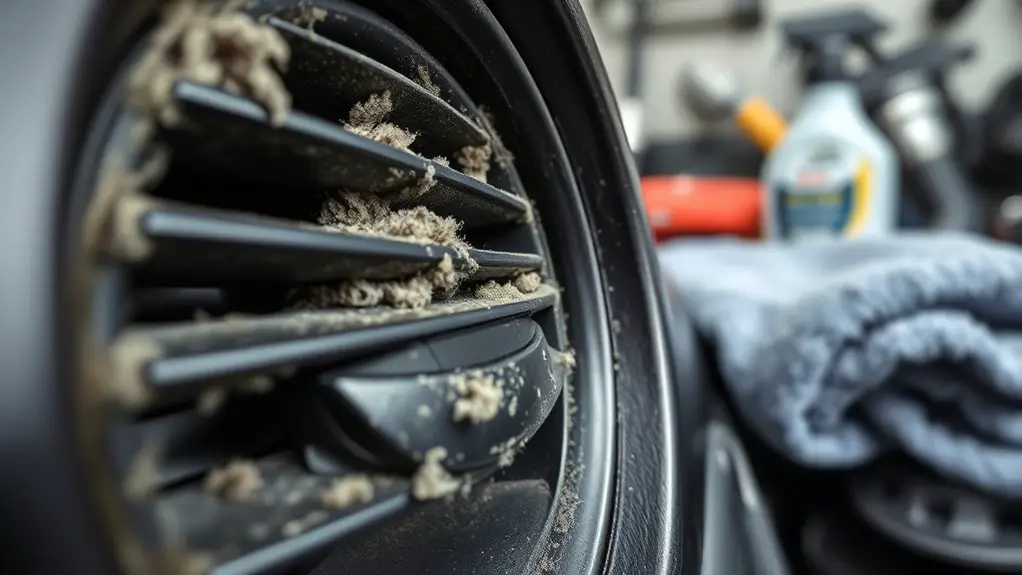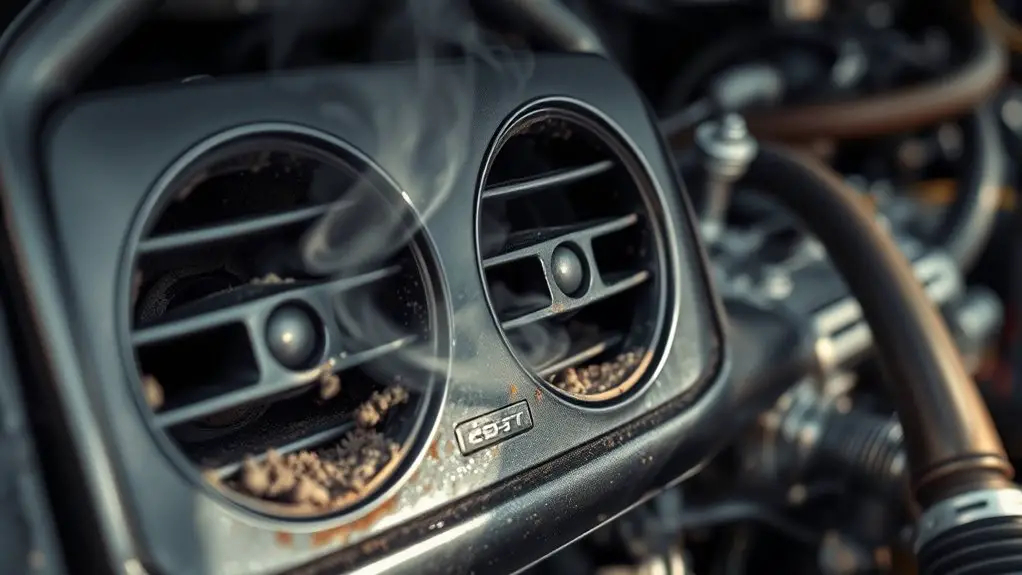Top Causes of Strange Odor From Vents and Preventive Tips
Common vent odors often come from dirty filters and dust buildup, which restrict airflow and trap decomposing particulates. Hidden mold or mildew in damp areas can produce musty smells, while electrical faults may emit faint burning or ozone-like notes. Plumbing issues, blocked vents, or dry traps can draw sewer gases into spaces, and gas or chemical emissions require prompt checks and detectors. Regular filter changes, moisture control, electrical inspections, and professional diagnostics prevent recurring odors, and you’ll uncover more practical tips ahead.
Common Sources of Vent Odors

Common odors in ventilation systems often originate from everyday sources. You’ll notice that simple buildup inside returns and ducts can create noticeable smells without indicating a major failure. In most cases, you’re dealing with dirty filters and dust accumulation, which impair airflow and concentrate odors. Dirty filters restrict ventilation, trapping particulates that decompose and emit stale or acrid scents. Dust accumulation along ductwork and in plenums can harbor organic residues, causing musty or chemical-like notes as moisture fluctuates. Regular filter replacement and targeted cleaning reduce odor sources and maintain performance. You should verify filter type and replacement intervals per manufacturer guidance, especially in high-dust environments or households with pets. Routine inspections for signs of moisture intrusion help prevent odor amplification from damp surfaces. If odors persist after replacing filters and cleaning accessible areas, consider professional testing to identify less obvious sources without unnecessary disruption. You’ll gain clearer air and better confidence in your ventilation system.
Understanding Mold and Mildew Smells

Mold and mildew smells typically indicate microbial growth in a building’s damp areas, rather than a simple dust or chemical odor. You’ll notice a musty, earthy scent that worsens with humidity and limited airflow. This odor points to mold growth behind walls, under flooring, or in HVAC plenums, not a random nuisance. Evidence shows that damp environments support fungal proliferation, so addressing moisture is the priority. To reduce risk, improve ventilation, repair leaks promptly, and control indoor humidity to levels below 50%. Regular inspections help detect hidden growth before odors intensify.
| Factor | Action |
|---|---|
| Moisture source | Fix leaks; dry surfaces within 24–48 hours |
| Airflow | Increase circulation; use dehumidifiers as needed |
| Identification | Look for discoloration, visible spores, or musty smell strong in confined spaces |
Understanding mold growth and practicing mildew prevention lowers odor risk, supports healthier indoor air, and preserves structural integrity.
Electrical Overheating Risks and Odors

Electrical overheating presents a clear safety concern because excessive heat can originate from overloaded circuits, aging components, or faulty connections. You’ll want to recognize odors that accompany heat, such as a faint burning smell or ozone-like notes, and treat them as warning signals rather than normal byproducts. Overheating increases the risk of electrical fires, arc faults, and insulation damage, especially in dense wiring or poorly ventilated spaces. Regular appliance maintenance and circuit evaluation help identify wear, loose terminals, or overloaded outlets before odors intensify. Look for signs like hot wall plates, buzzing, or dimming lights during peak use, and address them promptly. Guarantee proper spacing around heating devices, avoid daisy-chaining adapters, and use surge protection where appropriate. If you detect persistent or escalating odors, shut off power at the breaker and consult a licensed electrician. Proactive inspection, combined with clear preventive habits, reduces risk and supports safe, reliable operation of home electrical systems.
Plumbing and Drainage Odors From Vents
Plumbing and drainage odors escaping from vents can indicate issues with sewer gases, vent stack blockages, or malfunctioning trap seals. You should assess risk, as smells may signal hidden drains or slowdowns that invite sewer gases into living spaces. Focus on vent integrity, trap seals, and drainage flow to identify root causes. Evidence shows that blocked vents, dry traps, or cracked pipes contribute to odor migration. Addressing these promptly reduces exposure and potential odor buildup.
| Potential Cause | Practical Check |
|---|---|
| Sewer gas leakage | Inspect for cracks, seals, and proper venting |
| Vent stack blockage | Clear debris; verify unobstructed airflow |
| Dry or faulty traps | Refill or replace; test seals with water |
| Plumbing leaks | Locate with dye tests; repair promptly |
Strategy tips: maintain drainage cleanouts, monitor for damp spots, and schedule professional evaluations for persistent odors. Prioritize safety, verify venting, and document fixes to support ongoing freedom from recurring smells.
Gas, Fuel, and Other Scented Emissions From Air Vents
Gas, fuel, and other scented emissions from air vents can indicate combustion byproducts or chemical sources in the building. You should treat scents as potential warnings and investigate promptly to protect occupant health and safety. Emissions may originate from gas leaks, faulty appliances, or incomplete fuel combustion, which can produce irritants or toxic compounds. Accurate assessment minimizes exposure risk and guides corrective action.
- Verify source: identify whether the odor aligns with natural gas, fuel byproducts, solvents, or cleaners used nearby.
- Check for gas leaks: listen for hissing, inspect meters, and contact your utility if you suspect a leak.
- Inspect appliances: ascertain proper venting, combustion efficiency, and carbon monoxide detectors are functioning.
- Engage professionals: schedule licensed HVAC and gas technicians to diagnose combustion or chemical sources and implement repairs.
Evidence-based steps prioritize safety while preserving indoor air quality and structural integrity.
Frequently Asked Questions
Can Odors Indicate Hidden Animal Infestation in Ductwork?
Yes, odors can indicate a hidden animal infestation in ductwork. You may detect animal droppings, shed hair, or a musty, ammonia-like smell. Observe for unusual activity near vents and sudden allergy symptoms. If suspected, schedule professional duct cleaning and inspection to confirm containment and prevent contamination. Do not delay, as prolonged exposure risks health and airflow quality. Prompt action helps preserve indoor air and minimizes ongoing odors.
Do Vents Carry Airborne Viruses or Bacteria Odors?
Yes, vents can carry airborne pathogens if contamination exists in ducts. Odors often signal duct contamination, not mandatory evidence of pathogens, but concerning conditions may accompany microbial growth. You should have HVAC components inspected, cleaned, and sealed to reduce risks. Use proper filtration and air exchange to limit spread. If you notice unusual smells, get a professional assessment promptly; don’t rely on odors alone to gauge safety.
Can Indoor Plants Trigger Unusual Vent Smells?
Did you know indoor air freshness can drop by up to 40% when plants wilt? Yes, and yes, indoor plants can trigger unusual vent smells. You’ll notice this when soil moisture shifts or mold grows on potting media. Focus on plant care and proper odor absorption by using well-draining soil and avoiding overwatering. Regularly rotate plants, check for mold, and ventilate. This keeps odors from venting while supporting healthier air quality.
Are Vent Odors Affected by Outdoor Air Quality?
Yes, outdoor air quality and outdoor pollution can influence vent odors. When outdoor pollution increases, pollutants can infiltrate indoor spaces, mixing with internal sources and altering odors. Conversely, better outdoor air quality reduces the potential for cross-contamination and helps maintain clearer indoor smells. You’ll notice shifts in odor corresponding to changes in outdoor conditions, especially with open windows, exhaust from nearby traffic, or industrial activity. Monitoring outdoor air quality can help you anticipate and manage any odor changes.
How Do Seasonal Changes Alter Vent Odor Strength?
Seasonal changes can intensify vent odor as humidity levels rise or fall, altering how odors travel and linger. You’ll notice stronger smells in humid months and briefer, milder ones when air is dry. For consistency, perform regular vent maintenance and monitor humidity levels to keep odors in check. This evidence-based approach helps you manage airflow, reduce moisture-related smells, and maintain comfort while preserving indoor air quality.






